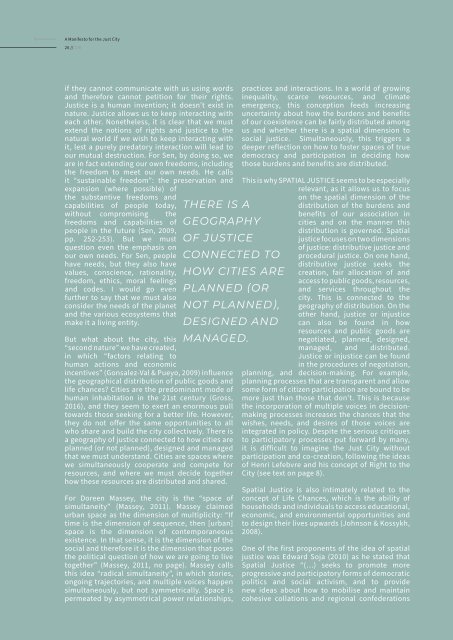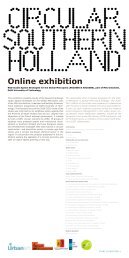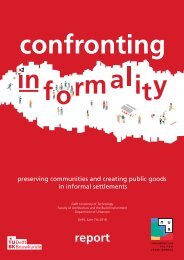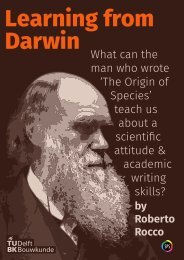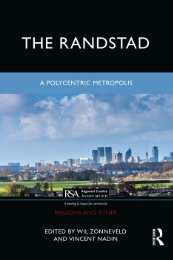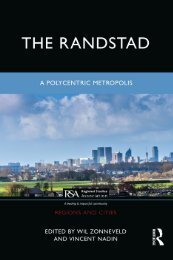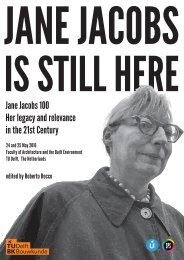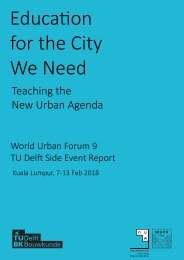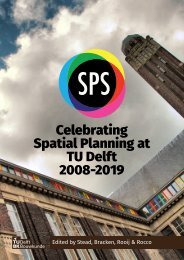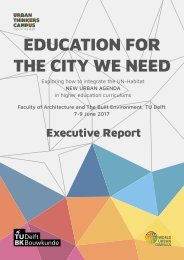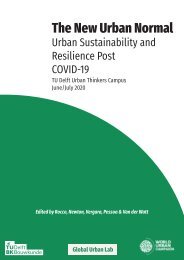A Manifesto for the Just City
On Monday 29 MARCH at 18:00 (CET/Amsterdam), TU Delft launched the Book "A Manifesto for the Just City", with texts by a number of guests and 43 manifestos written by students from 25 universities from all over the world. A “Manifesto for the Just City” comes in the wake of the realisation that socio-spatial justice is a crucial dimension for sustainability transitions. Growing inequality and the erosion of the public sphere undermine the social and political structures required to fight climate change, pandemics and other systemic shocks. With this book, we have sought to encourage students to formulate their own visions for the Just City and for a just transition. This book is result of an Urban Thinkers Campus organised between 9 and 30 November 2020. The Urban Thinkers Campus (UTC) model is an initiative of UN-Habitat’s World Urban Campaign, conceived in 2014 as an open space for critical exchange between stakeholders and partners. It aims to promote debate and action on sustainable and inclusive urbanization upholding the principles and guidelines contained in the New Urban Agenda, launched at Habitat-III in 2016 in Quito, Ecuador.
On Monday 29 MARCH at 18:00 (CET/Amsterdam), TU Delft launched the Book "A Manifesto for the Just City", with texts by a number of guests and 43 manifestos written by students from 25 universities from all over the world.
A “Manifesto for the Just City” comes in the wake of the realisation that socio-spatial justice is a crucial dimension for sustainability transitions. Growing inequality and the erosion of the public sphere undermine the social and political structures required to fight climate change, pandemics and other systemic shocks. With this book, we have sought to encourage students to formulate their own visions for the Just City and for a just transition.
This book is result of an Urban Thinkers Campus organised between 9 and 30 November 2020. The Urban Thinkers Campus (UTC) model is an initiative of UN-Habitat’s World Urban Campaign, conceived in 2014 as an open space for critical exchange between stakeholders and partners. It aims to promote debate and action on sustainable and inclusive urbanization upholding the principles and guidelines contained in the New Urban Agenda, launched at Habitat-III in 2016 in Quito, Ecuador.
You also want an ePaper? Increase the reach of your titles
YUMPU automatically turns print PDFs into web optimized ePapers that Google loves.
A <strong>Manifesto</strong> <strong>for</strong> <strong>the</strong> <strong>Just</strong> <strong>City</strong><br />
26 // 276<br />
if <strong>the</strong>y cannot communicate with us using words<br />
and <strong>the</strong>re<strong>for</strong>e cannot petition <strong>for</strong> <strong>the</strong>ir rights.<br />
<strong>Just</strong>ice is a human invention; it doesn’t exist in<br />
nature. <strong>Just</strong>ice allows us to keep interacting with<br />
each o<strong>the</strong>r. None<strong>the</strong>less, it is clear that we must<br />
extend <strong>the</strong> notions of rights and justice to <strong>the</strong><br />
natural world if we wish to keep interacting with<br />
it, lest a purely predatory interaction will lead to<br />
our mutual destruction. For Sen, by doing so, we<br />
are in fact extending our own freedoms, including<br />
<strong>the</strong> freedom to meet our own needs. He calls<br />
it “sustainable freedom”: <strong>the</strong> preservation and<br />
expansion (where possible) of<br />
<strong>the</strong> substantive freedoms and<br />
capabilities of people today,<br />
without compromising <strong>the</strong><br />
freedoms and capabilities of<br />
people in <strong>the</strong> future (Sen, 2009,<br />
pp. 252-253). But we must<br />
question even <strong>the</strong> emphasis on<br />
our own needs. For Sen, people<br />
have needs, but <strong>the</strong>y also have<br />
values, conscience, rationality,<br />
freedom, ethics, moral feelings<br />
and codes. I would go even<br />
fur<strong>the</strong>r to say that we must also<br />
consider <strong>the</strong> needs of <strong>the</strong> planet<br />
and <strong>the</strong> various ecosystems that<br />
make it a living entity.<br />
THERE IS A<br />
GEOGRAPHY<br />
OF JUSTICE<br />
CONNECTED TO<br />
HOW CITIES ARE<br />
PLANNED (OR<br />
NOT PLANNED),<br />
DESIGNED AND<br />
MANAGED.<br />
But what about <strong>the</strong> city, this<br />
“second nature” we have created,<br />
in which “factors relating to<br />
human actions and economic<br />
incentives” (Gonsalez-Val & Pueyo, 2009) influence<br />
<strong>the</strong> geographical distribution of public goods and<br />
life chances? Cities are <strong>the</strong> predominant mode of<br />
human inhabitation in <strong>the</strong> 21st century (Gross,<br />
2016), and <strong>the</strong>y seem to exert an enormous pull<br />
towards those seeking <strong>for</strong> a better life. However,<br />
<strong>the</strong>y do not offer <strong>the</strong> same opportunities to all<br />
who share and build <strong>the</strong> city collectively. There is<br />
a geography of justice connected to how cities are<br />
planned (or not planned), designed and managed<br />
that we must understand. Cities are spaces where<br />
we simultaneously cooperate and compete <strong>for</strong><br />
resources, and where we must decide toge<strong>the</strong>r<br />
how <strong>the</strong>se resources are distributed and shared.<br />
For Doreen Massey, <strong>the</strong> city is <strong>the</strong> “space of<br />
simultaneity” (Massey, 2011). Massey claimed<br />
urban space as <strong>the</strong> dimension of multiplicity: “If<br />
time is <strong>the</strong> dimension of sequence, <strong>the</strong>n [urban]<br />
space is <strong>the</strong> dimension of contemporaneous<br />
existence. In that sense, it is <strong>the</strong> dimension of <strong>the</strong><br />
social and <strong>the</strong>re<strong>for</strong>e it is <strong>the</strong> dimension that poses<br />
<strong>the</strong> political question of how we are going to live<br />
toge<strong>the</strong>r” (Massey, 2011, no page). Massey calls<br />
this idea “radical simultaneity”, in which stories,<br />
ongoing trajectories, and multiple voices happen<br />
simultaneously, but not symmetrically. Space is<br />
permeated by asymmetrical power relationships,<br />
practices and interactions. In a world of growing<br />
inequality, scarce resources, and climate<br />
emergency, this conception feeds increasing<br />
uncertainty about how <strong>the</strong> burdens and benefits<br />
of our coexistence can be fairly distributed among<br />
us and whe<strong>the</strong>r <strong>the</strong>re is a spatial dimension to<br />
social justice. Simultaneously, this triggers a<br />
deeper reflection on how to foster spaces of true<br />
democracy and participation in deciding how<br />
those burdens and benefits are distributed.<br />
This is why SPATIAL JUSTICE seems to be especially<br />
relevant, as it allows us to focus<br />
on <strong>the</strong> spatial dimension of <strong>the</strong><br />
distribution of <strong>the</strong> burdens and<br />
benefits of our association in<br />
cities and on <strong>the</strong> manner this<br />
distribution is governed. Spatial<br />
justice focuses on two dimensions<br />
of justice: distributive justice and<br />
procedural justice. On one hand,<br />
distributive justice seeks <strong>the</strong><br />
creation, fair allocation of and<br />
access to public goods, resources,<br />
and services throughout <strong>the</strong><br />
city. This is connected to <strong>the</strong><br />
geography of distribution. On <strong>the</strong><br />
o<strong>the</strong>r hand, justice or injustice<br />
can also be found in how<br />
resources and public goods are<br />
negotiated, planned, designed,<br />
managed, and distributed.<br />
<strong>Just</strong>ice or injustice can be found<br />
in <strong>the</strong> procedures of negotiation,<br />
planning, and decision-making. For example,<br />
planning processes that are transparent and allow<br />
some <strong>for</strong>m of citizen participation are bound to be<br />
more just than those that don’t. This is because<br />
<strong>the</strong> incorporation of multiple voices in decisionmaking<br />
processes increases <strong>the</strong> chances that <strong>the</strong><br />
wishes, needs, and desires of those voices are<br />
integrated in policy. Despite <strong>the</strong> serious critiques<br />
to participatory processes put <strong>for</strong>ward by many,<br />
it is difficult to imagine <strong>the</strong> <strong>Just</strong> <strong>City</strong> without<br />
participation and co-creation, following <strong>the</strong> ideas<br />
of Henri Lefebvre and his concept of Right to <strong>the</strong><br />
<strong>City</strong> (see text on page 8).<br />
Spatial <strong>Just</strong>ice is also intimately related to <strong>the</strong><br />
concept of Life Chances, which is <strong>the</strong> ability of<br />
households and individuals to access educational,<br />
economic, and environmental opportunities and<br />
to design <strong>the</strong>ir lives upwards (Johnson & Kossykh,<br />
2008).<br />
One of <strong>the</strong> first proponents of <strong>the</strong> idea of spatial<br />
justice was Edward Soja (2010) as he stated that<br />
Spatial <strong>Just</strong>ice “(…) seeks to promote more<br />
progressive and participatory <strong>for</strong>ms of democratic<br />
politics and social activism, and to provide<br />
new ideas about how to mobilise and maintain<br />
cohesive collations and regional confederations


